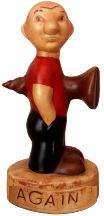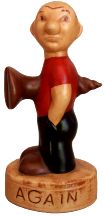 |
 The Virtual Corkscrew Museum's Weekly Newspaper |
 |
 |
 The Virtual Corkscrew Museum's Weekly Newspaper |
 |
|
Sunday, May 7, 2006 |
Argentina Affairs
by Danny Arensman

The Netherlands & Buenos Aires, Argentina - The original bottle, issued in 1970 together with the folding corkscrew as mentioned in several corkscrew books as rare. Having the bottle and the corkscrew together … that is rare. I know only one person more who has a bottle and that's my friend who gave his second one to me. He is an antique
dealer in San Telmo and a good friend, Alberto Oscar Boto. Whenever you plan to visit Buenos Aires you have to visit his antique shop. The address is: KALIF Antiques shop Av.San Juan 429 , (1147) San Telmo, Ciudad Aut.De Bs.As.
The protecting swivel at the end of the corkscrew is not to assist by pulling the cork but to protect the end of the screw-points when the corkscrew is folded.
The corkscrew itself is not a waiter's friend lever but a double helix to pull the cork easy. The handle is decorated with glasses, grape and grapevines and leaves and on one side is Centenario and on the reverse side is Graffigna.
My friend Alberto told me that Graffigna is the name of a Winery and Centenario is the number of years we all like to reach……. To avoid any misunderstanding about the age of the corkscrew, it is from 1970
Say Cheese
Sterling Silver Cheese Knobs and Corks
Corkscrew Mystery Response
The mysstery corkscrews pictured in the April 30 edition made with rings of different materials / colors secured on a metal bar. Reader Alan Sharpstone, London, U.K., added his corkscrew to the mystery and reports "I bought mine in a market in Lymington Hampshire UK about six years ago.I paid the equivalent of about nine US dollars.I also would be interested to learn more about it.It looks 30's to me.It looks like it could be part of a matching cocktail set.
Corkscrew Mystery - Who is this Character?
Wirtz, Virginia - Does anyone have any information on this corkscrew or any similar examples? Age? Manufacturer? Catalog pages? Other details?
Does anyone recognize this comic character?
"Caveat Emptor" Singleton? Corkscrew
Reported by Ron MacLean
I recently acquired a mechanical corkscrew on line thinking, from published information and photographs available, it could be an early circa 1780 example. The only reference known on this design is found in Corkscrews of the Eighteenth Century ©1995 by Bert Giulian.
Upon arrival my initial excitement rapidly turned to suspicion as I studied its design and construction. The following report is a detailed analysis and opinion based on my engineering and collecting perspective:
Length 7 1/2" ready to use, 8 1/2" closed, with an open barrel (with lathe turned decorative rings) that appears to be a contemporary piece of seamless steel tubing/pipe, 3 11/16" long, 1 5/16" diameter, 1/16" thick. It has no brazed or forge welded seams, flow lines or slag inclusion nor any signs of forge working of any kind.
The 7/16" thick cast dome (not forged as expected) is inset into the top of the barrel and provides sufficient support to keep the worm more or less centered without a spring.
The heavy cast sheath hole fitting for the handle (again not forged) is not "threaded" but has a smooth tapered oval opening.
The tapered sheath is a modern steel casting with a distinctive reinforcement collar to accommodate thread turned into the cavity. It was definitely not made from forged iron and does not have the usual longitudinal brazed seam, end cap and threaded insert of an early picnic corkscrew sheath.
The cast sheath (3 3/8" long - about 3/8" longer than required for the helix) is a real waste of precious material for the late 18th century. It has 16 concentric tight flat rings (not threads) that allow the sheath to be twisted and wedged into the handle hole.
The perfect long pitch 7/16" diameter wire helix is effective. It appears to be brazed into a commercial tubing collar (flat sides filed round) on the end of an English Thomason 5 start iron shaft, which has been filed circular to tidy up the joint. This shaft provides an unbelievable 2 13/16" extraction far in excess of that required for cork removal in the late 18th century. The shaft length is another excessive waste of material.
The fine threads on the sheath and shaft collar are metric (1 mm per thread) indicating possible European manufacture.
The barrel openings seem spatially and dimensionally just too well executed to be indicative of period whitesmithing.
Aall parts, except the multistart thread and the inside surfaces of the barrel, have been given an overall artificially acid aged patina.
Unfortunately it appears this example, by a modern master, is a well-made but cleverly deceptive period possibility, fortunately not a "fake" as it is not marked, works quite well, and has an interesting story to impart.
I caution you, both the neophyte and seasoned collector, things are not always as they seem!
Art Santen Stars
St. Louis, Missouri - Just for Openers member Art Santen was recently interviewed on KETC TV. The reporter and camera crew visited his St. Louis home which houses over 33,000 openers and corkscrews. And that incredible quantity of openers and corkscrews earned Art a place in the Guninness Book of World Records. Spend about 10 minutes watching this fun interview with Art - click here.
Don't Leave Me This Way
In the May 3, 2006 edition of the Sydney Morning Herald, James Cockington wrote an article about inheritances and cashing in before you check out. Here is an excerpt from the article:
In April last year, Charles F. Lane, a 90-year-old retired merchant banker and cattle breeder, sold his collection of 60 vintage corkscrews at Christie's in Melbourne, and was amazed to receive more than $25,000 for the lot. This was a novel form of inheritance for his five children. All collectors are faced with the same problem as they get old. Lane's solution was to transform his collection into money.
And this article appeared in the March 1 edition of Australia's The Age:
What a Corker
An auction with a twist is offering a selection of antique corkscrews, writes Jill Stark.
They look like medieval instruments of torture, but to Charles F. Lane they’re things of great beauty. He’s amassed his collection of antique corkscrews across several continents and four decades, and at the age of 92 there aren’t many pieces left to add to his set.
So it was with a mixture of pride and sadness that he offered this rare collection to Christie’s auction house in South Yarra. In a series of lots that is sure to have antiques enthusiasts salivating, 60 corkscrews will go under the hammer today in the first sale of its kind in Australia. They’ll be sold in an auction that also includes a collection of antique music boxes and a series of historical land grants and documents — including blueprints to the Sydney Harbour Bridge and a snuff box inscribed by Lachlan Macquarie.
But Lane’s prized corkscrews dating back to the 1800s are perhaps the most peculiar items on sale. Some wouldn’t look out of place on a surgeon’s table, others are ornately carved in wood or bone, but all offer a glimpse to a time when craftsmanship triumphed over convenience. \
Lane’s love affair with corkscrews began in 1961 when he visited an auction at Christie’s in London. “That made me get serious about collecting them,” he explains. “The ingenuity of the mechanical efficiency fascinates me. Today’s corkscrews are like the screw-pull variety. There’s no ingenuity in corkscrews today; it’s just a Teflon-coated wire, and they just don’t compare. When you get the quantity that I have, you’re very lucky to find one you haven’t already got; they’re becoming scarce.”
Like a schoolboy hunting for the last elusive football sticker to complete the set, Lane recently realised there wasn’t much left on the market he didn’t already own.
“It’s disappointing when you’re traipsing around various antique dealers in different countries trying to track down corkscrews they might have, only to find they’re the same as the ones you already own. I’m always looking for one I haven’t got,” he says. But the motivation to sell goes beyond mere frustration. “When you’re pushing 90 you have to start thinking about what you’re going to do with your residues,” he says. “I have five children — how you would split that collection between five wouldn’t be on. So I’ve decided to sell them, and then I can easily divide the proceeds. But now I’m looking at them again, it’s quite sad to be selling them.”
Bidding will start from $150 to $800 for individual pieces, and Lane, from Toorak in Melbourne, can expect to net anything between $20,000 and upwards of $30,000 for the set.
While corkscrew fanatics are common in Europe, Lane and his unusual hobby are in the minority in Australia, making his collection even more mouth-watering to local experts. Jennifer Jones, decorative arts specialist for Christie’s, says it was a rare find. “The beauty of this collection is that it’s out here in Australia,” she says. “I’ve become very attached to them. It’s not something you see every day, so there’s a great deal of interest. I used to work for Christie’s in London, and they have specialist corkscrew auctions once or twice a year where there can be 400 lots of corkscrews and Champagne taps. This is the first thing like it in Australia as far as I’m aware.”
Among the pieces in the varied collection is a cumbersome brass bar corkscrew inscribed with the title “The Don”. Also expected to attract attention are a novelty German piece in the shape of a pair of lady’s legs and several corkscrews with shaving-style brushes attached — used to brush away cork residue. While latterly Lane sourced his corkscrews through Melbourne antiques dealers, it was his job as a merchant banker in the UK and continental Europe that led him to the majority of his collection. “London was a good source — it’s the hub of the world, not just in antiques,” he says. “Germany was also good, and France, too. I was privileged to travel a lot in my job. Strangely, you can pick up one (corkscrew) in one country and see the same thing in another. Because there’s been people like me — collectors over time — the supply of antique corkscrews is almost non-existent now. You can’t buy them. That indicates a value for anyone who buys one — it’s worth buying.”
Asked to pick a favourite, Lane is unable to choose. “They’re all special to me. They’re all individual and there are no duplications in any of them. The corkscrews were always a hobby I never looked at it as an investment. My family have always been interested in my collection, and even when they’ve been travelling, they might come across one they thought I didn’t have and let me know — I had my spies out there” Lane will be eagerly watching when his collection is sold off, and while he’ll be sad to part with them, he remains pragmatic. “I’m apprehensive, because I don’t think they’ll bring the prices I think they’re worth, but I’m too old to get nervous. Once you sell something it’s gone, otherwise you’d tear yourself to bits. Golf will be my only hobby now. I won’t be looking anymore once I sell my collection.”
|
©2006 Don Bull, Editor |